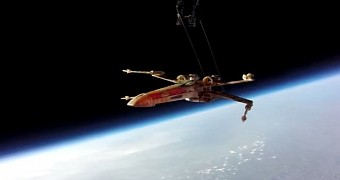Star Wars: The Force Awakens is set to open in theaters in this year's December. Eager to get tickets to the movie premiere, fans Matt Kingsnorth and Phil St Pier did more than just cross their fingers and pray to the heavens above. Probably because they knew this wouldn't work.
Instead, these guys designed and put together a miniature X-wing fighter plane, which they then flew into space. Although made of plastic, their aircraft made it all the way to an altitude of 120,000 feet (some 36,000 meters), DM tells us.
The Star Wars fans, both from the UK, documented the plastic plane's adventure in space with the help of a GoPro camera and posted the video online. They keep hoping movie director J.J. Abrams will see it or at least hear about it and offer them the tickets they so desperately want.
“Hey, J.J. Abrams! Can we have 2 tickets to the VIP premiere of The Force Awakens? Ordinarily the answer would be no... So we thought we'd try something extraordinary,” they write in a message accompanying their video.
For now, there's no news that J.J. Abrams might at least consider inviting Matt Kingsnorth and Phil St Pier to the VIP premiere of Star Wars: The Force Awakens. Then again, December isn't exactly around the corner, so maybe the pair will eventually score the tickets.
How does a plastic plane make it into space?
Since their miniature X-wing fighter plane was made of plastic, Star Wars fans Matt Kingsnorth and Phil St Pier couldn't fit it with a proper engine, not even a teeny tiny one. If they did, the plane would have probably melted long before reaching space.
To get the model plane to achieve takeoff and soar above the clouds, the science enthusiasts came up with a very simple and yet totally effective solution. Long story short, they tied it to a weather balloon which they filled with helium.
True, the balloon they used wasn't exactly a top-notch propulsion system, but it got the job done. In fact, it worked so well rumor has it NASA too might start tying helium balloons to its spacecraft rather than use state-off-the-art rockets to launch them on their missions.

 14 DAY TRIAL //
14 DAY TRIAL // 